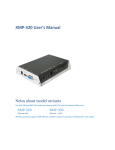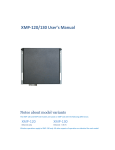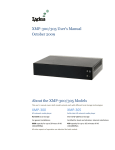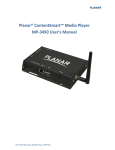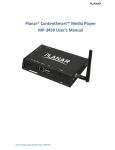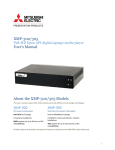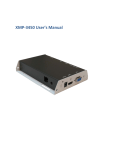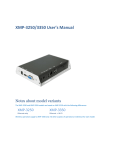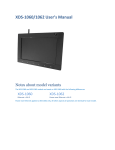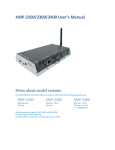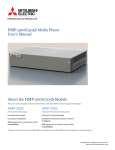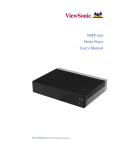Download NMP-200U User's Manual
Transcript
XMP-320 User’s Manual Notes about model variants The XMP-320 and XMP-330 models differ in networking functionality: XMP-320 XMP-320 Ethernet only Ethernet + Wi-Fi All other aspects of operation are identical for each model. Contents 1. Introduction 1 1.1. Features 1 1.2. Package contents 1 1.3. Installation provisions 1 1.4. Physical ports and features 1 Setting up the system 3 2. 2.1. System connections 3 2.2. Entering menu configuration via USB keyboard 3 2.3. Navigating the menus 3 2.4. Connect the XMP-320/330 to your network 3 3. Clock and calendar settings 4 3.1. Audio volume settings 4 3.2. Video output settings 5 3.3. Setting a password 5 4. Factory reset 4.1. 5 Applying firmware upgrades 6 5. Content Management 7 6. Working with SMIL 8 6.1. Introduction 8 6.2. www.a-smil.org for Developers 8 7. Technical Data 7.1. 8. Specifications Appendix: FAQ i 9 9 11 1. Introduction This document describes the hardware and software operations of the XMP-320/330, system set up, and frequently asked questions. 1.1. Features The XMP-320 is a Full-HD 1080p high definition digital signage player featuring industrial grade mechanical design and versatile open-standard SMIL programmability. Full-HD 1080p hardware decoding of MPEG, H.264, and VC-1 media formats 4GB on-board flash local storage with CF expansion slot Integrated audio and video output via HDMI Supports full POPAI Screen Media Formats Standards profiles S1 to S12, and E1 to E9 Multiple 3rd party software solution compatibility Industry leading W3C SMIL support for developers 1.2. Package contents Main Unit AC Adapter 3.5mm to RCA AV cable Ethernet cable Wi-Fi antenna (XMP-130 only) NOT INCLUDED: A USB keyboard is required for system setup 1.3. Installation provisions The XMP-320 has VESA MIS-100D compatible mounting flanges for physical installation. (For XMP-330 only) ATTACH the wireless antenna as shown in physical views. Screw the antenna clockwise onto the antenna post 1.4. Physical ports and features 1 Quick Start Guide I/O connections 1 2 3 4 Ethernet port for network content update 5 6 7 8 Stereo RCA audio output USB port for USB content update VGA port for analog video output HDMI 1.3a connector for digital video and audio combined outputs, or digital video via option DVI adapter 12V DC for power adapter S/W Reset button to perform factory reset (see section 2.4) Reserved (not enabled: COM, SPDIF, VIDEO-IN, AUDIO-IN L/R) 2 2. Setting up the system 2.1. System connections 1 CONNECT the player to your display with an HDMI, VGA, or supplied 3.5mm composite AV cable, and switch your display on to the corresponding input mode. 2 ATTACH the AC power adapter → main unit status LED lights up and you should see “Starting up” on screen 3 WAIT while player boots up (~ 90 seconds) → once you see “Welcome” on screen, the unit is ready for content update or menu configuration 2.2. Entering menu configuration via USB keyboard Initially, the player will boot into the “Welcome!” screen. PLUG IN a USB keyboard to enter configuration menus. The menu and blue background will appear in about 30 seconds. If you have already loaded media contents into the player, contents will play back immediately after boot up, and the “Welcome!” screen will not be shown. You can still plug in a USB keyboard at any time during playback to enter the menu system. → PLUG IN a USB keyboard (not supplied) to the unit’s USB port. The player will enter the graphical menu system in approx. 30 seconds If you have set up a password, the menu will not be displayed until you press Ctrl-Alt-Del 2.3. Navigating the menus You must attach a USB keyboard (not supplied) to the XMP-320/330 to configure settings. With the player booted up and ready, it takes approximately 30 seconds after you plug in the keyboard for the following menu to be displayed: Navigate the menus using arrow keys, space bar, enter key, ESC, and numeral keys on your USB keyboard. Use the keyboard arrow keys to highlight menu items, press the space bar to move the star (cursor), and then press enter to confirm (<OK>) or reject (<Cancel>) any changes. 2.4. Connect the XMP-320/330 to your network Wireless connection (wireless model only) The player will scan for wireless signals nearby during boot up. If the network requires authentication, you will be asked to provide the password for access. Wired connection To use the wired Ethernet connection, connect an Ethernet cable and the Wi-Fi will be disabled. Player IP address You will also need an IP address for the player on your network. This could be set automatically (DHCP) or manually (static IP): DHCP – automatically assign network IP address DHCP is enabled by default. You do not need to change the settings unless setting a static IP. Static IP – manually assign network IP address Highlight “IP configuration” and press “Enter” on keyboard to <Select> Move the highlight to “Static IP” below, press “Space bar” on the keyboard to fill in the star (*) at the Static IP brackets, and press “Enter” on the keyboard to select <OK>. 3 Proceed to configure an available static IP address. Select Wireless configuration or IP configuration as determined by your connection. Please consult your network administrator if necessary. 3. Clock and calendar settings It’s important to set the correct time and time zone for schedule playback. Highlight “Time setting” and press “Enter” on keyboard to <Select> SET local time, then SET time zone. Daylight Saving (DST) rules can be configured when you enter the Set time zone submenu. 3.1. Audio volume settings From the Main Menu, select Output setting to enter the submenu. You can enter the sound level in percentage (%) from 0(quietest) to 100 (loudest) or in decibels (db) from -22 (quietest) to 0 (loudest) 4 3.2. Video output settings For best quality, set the output resolution to match your display’s native resolution to avoid image scaling and blur. If you are connecting to an LCD TV, the resolution setting is most likely 1366x768 or 1920x1080 If you are connecting a LCD computer monitor, projector, or plasma display, refer to the device specifications for the best matching setting. Press the space bar to fill in the star (*) before pressing the enter key for <OK>. 3.3. Setting a password To prevent your player settings from being modified by unauthorized personnel, set a player password to hide the menus. From the top level menu, select Change password to set a password. Once a password is set, you can only access the menus by connecting a USB keyboard and pressing CONTROL + ALT + DELETE (3-key combination) simultaneously. You may connect the keyboard at any stage of player operation or before/ during boot-up. If you forget the password, you will need to reset the device. See Factory reset. 4. Factory reset Using a USB keyboard If you forget a system password you have set, you must reset the system to regain access to the player. System reset will re-initialize the system, clear passwords, and return settings to their default values. Perform the following: 1 2 CONNECT USB keyboard REBOOT the player and look for the reset instructions on the top left corner of the screen. When it appears, PRESS the Delete key on your keyboard If you missed the reset window, unplug power and try again 3 4 You should see a menu with a reset confirmation dialogue box. SELECT Yes to confirm WAIT while system reboots to complete reset Using the reset button 1 2 Press and hold the reset button with a pin Re-connect the power cord 5 3 4 In about 8 seconds, the status LED flashes Release reset button and wait for system to initialize 4.1. Applying firmware upgrades Firmware updates can be performed using a USB flash drive or via network, depending on your management software solution. Please read the release notes carefully regarding the changes that will be made before you perform the upgrade 1 2 3 4 Obtain the latest firmware and copy it to the root directory of a USB drive Power on device and plug USB keyboard to the device to enter menu system Follow on screen instructions and select firmware upgrade option in the menu When instructed, plug in the USB drive to begin firmware upgrade 6 5. Content Management Please consult the software documentation for information specific to your management solution 7 6. Working with SMIL The XMP-320/330 uses open communications protocols for highly flexible content presentation and playback control. SMIL-compliance means predictable results across multiple devices, and SMIL’s non-proprietary nature means that your investments are never obsolete. 6.1. Introduction Using SMIL (pronounced “smile”), the language created by W3C for multimedia communications, the media player understands the language “spoken” by professional tools from companies such as Adobe, Apple, Microsoft, and Real Networks. What this means is quicker, easier, and better integration of your players into your digital signage networks, opening up avenues of software controls and realizing the full potential of your player hardware down the road. 6.2. www.a-smil.org for Developers For resources, downloads, and community support, please visit www.a-smil.org. 8 7. Technical Data 7.1. Specifications XMP-320 XMP-330 Video format support POPAI Screen Media Standards S6 (MPEG-1 SIF, 3Mbps CBR) S7 (MPEG-1 480p, 10Mbps CBR) S8 (MPEG-1 720p, 15Mbps CBR) S9 (MPEG-2 480p, 6Mbps CBR) S10 (MPEG-2 720p, 12Mbps CBR) S11 (MPEG-4 AVC, 480p, 6Mbps CBR) S12 (MPEG-4 AVC, 720p, 10Mbps CBR) E4 (VC-1/WMV9, MP@ML, 720p)* E5 (VC-1/WMV9, MP@HL, 1080p)* E6 (MPEG-2, 1080p, 20Mbps CBR) E7 (MPEG-4 ASP, 480p, 10Mbps CBR) E8 (MPEG-4 AVC, 1080p, 25Mbps CBR) Image format support POPAI Screen Media Standards S1 (JPEG 480p baseline) S2 (JPEG 720p baseline) S3 (JPEG 1080p baseline) E1 (PNG 24bpp+alpha, 480p) E2 (PNG 24bpp+alpha, 720p) E3 (PNG 24bpp+alpha, 1080p) Audio codec support POPAI Screen Media Standards S4 (MPEG L2 audio) S5 (MP3 audio, 384Kbps) Playback control W3C SMIL 3.0 instructions (sub-set) Content management 3rd party solution Physical I/O connectors HDMI 1.3 VGA 3.5mm AV out RJ45 Ethernet USB 2.0 Mounting solution Metal mounting flange @ 140mm x 75~100mm pitch Digital Signage Features VESA mounting flange compatible with MIS-D 100 “Power auto on” upon power cord attach Automatic error recovery (built-in WDT) Real-time clock with 12-hour backup battery Automatic NTP clock adjustment Local storage Internal 2GB NAND flash (up to 1.8 hrs of 5 Mbps high def. video) CF card expansion slot (CF card disables internal memory) Accessories 3.5mm to RCA AV cable Ethernet Cable Printed quick start guide AC power adapter Power requirement Input: 100V-240V 50-60Hz Output: 12V, 1.5A DC Power consumption* 8 watts max Environmental Operating temperature: 0 – 40° C / 32 – 104° F 9 HDMI 1.3 VGA 3.5mm AV out RJ45 Ethernet USB 2.0 Wi-Fi antenna port 3.5mm to RCA AV cable Ethernet Cable Printed quick start guide AC power adapter Wi-Fi antenna Humidity: 5 – 85% @ 40° C / 32 – 104° F non-condensing Dimensions 211x153x 43mm (8.3 X 6 X 1.7 inches) Weight 347 grams (0.76 lbs.) Safety UL-approved AC adapters Certifications CE/FCC RoHS Warranty One-year limited parts & labor 10 360 grams (0.79 lbs.) 8. Appendix: FAQ Why is there no video output on composite video connectors? The player outputs video over HDMI and VGA by default. To switch to composite video output, change the settings in the menu system. What video output can work simultaneously? VGA & HDMI can output simultaneously. If player switch to composite out, then composite will be the only available video out If both Ethernet & Wi-Fi are available, which connection will take priority? When Ethernet is not available or disconnected, system will try to use Wi-Fi connection. If both connections are available, Ethernet will take priority for data transfer. How do I remove the CF card? The CF card is designed as a permanent storage not for plug-and-play use (consult http://www.digisignage.com on how to install). Use the hook on the included CF slot clip to carefully remove the CF card. What is the maximum file size for a single video file? The maximum video file size for the XMP-320/330 is 2GB, even when using a larger SD card. Recommend file size is 1850MB or less. How do I manage the playback of contents? rd The XMP-320/330 is designed to be interoperable with leading 3 party management software solutions or via SMIL open standard commands. Why won’t some media files play properly? The video data bit-rate may be higher than the recommended bit rate. The video data bit-rate is the amount of video or audio data used per second to store or play the contents, usually expressed in Mbps (mega-bits per second). Video encoded with excessive bit-rates will not playback smoothly in the media player, likely due to storage i/o bottleneck. Visit www.digisignage.com for compatible media format presets. Some JPEG images cannot be played in the media player. Progressive JPEG are not supported. Please convert to baseline JPEG for maximum compatibility. JPEG images can be either of 2 types: baseline or progressive compression. Baseline JPEG offers greatest compatibility, while progressive JPEGs are suitable for web site images. Progressive images are downloaded and displayed “progressively,” being rendered more clearly as more data is received over the internet. Dedicated media player and embedded systems are usually incompatible with the latter type. Make sure to save images as baseline JPEG in your photo editor, or resave them as baseline JPEGs using free tools such as Paint.net (http://www.paint.net/). Does the media player support video streaming? No, all media files are designed to play from local storage (built-in flash, SD card, or CF card). During content and schedule sync, contents are transferred to player’s local storage before being presented on screen. This ensures the best possible presentation and fluid delivery of your video message. Video streaming raises many playback quality issues such as image freezing, blocking, or blue-screens, costing you valuable “air time” and losing your audience's attention. The media player is not playing. What should I do? Check the player’s messages on the display (OSD, or on screen display) for status information. Since dedicated media players usually lack input devices such as keyboard or mouse like PCs, troubleshooting is usually based on user’s knowledge and experience with the specific media player. First check the on screen message and stats reports. Bad play list and timing issues are two major causes of playback problems. To determine if the problem is caused by a bad play list, just delete the play list and restart player. The player should loop through all media files, indicating a fault with the play list. 11 If the playback is scheduled to play at specific time, check to see if the device is set to the right time zone on the world clock. When nothing seems wrong, the time zone setting is often the reason the program is not played. 12














